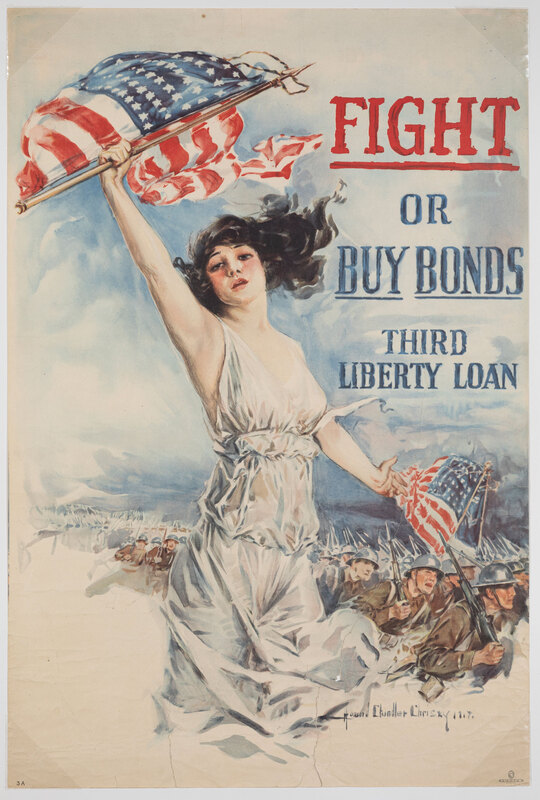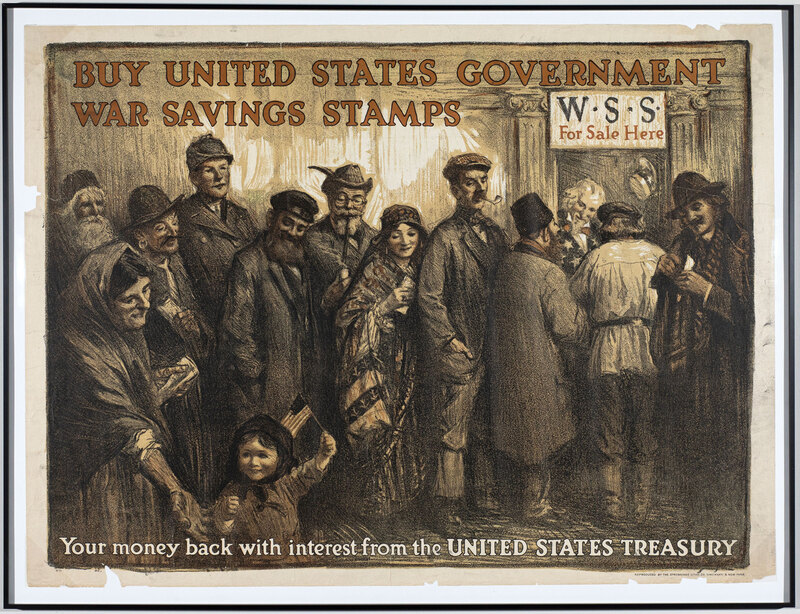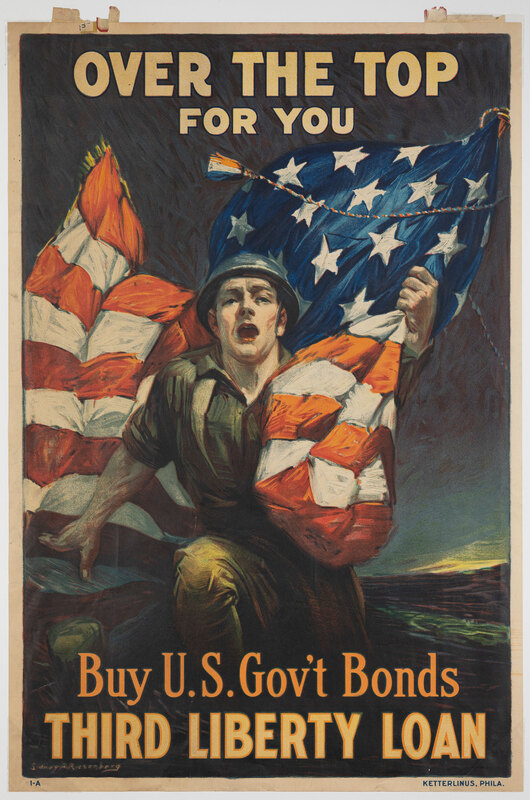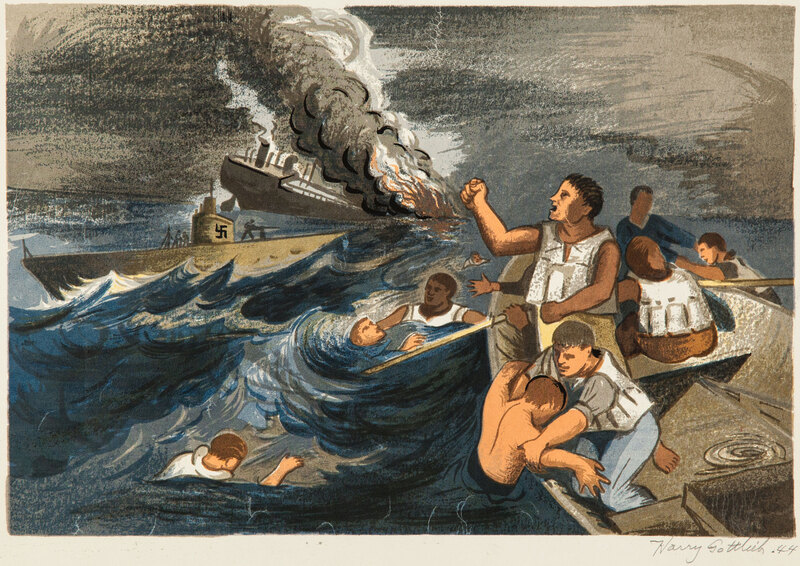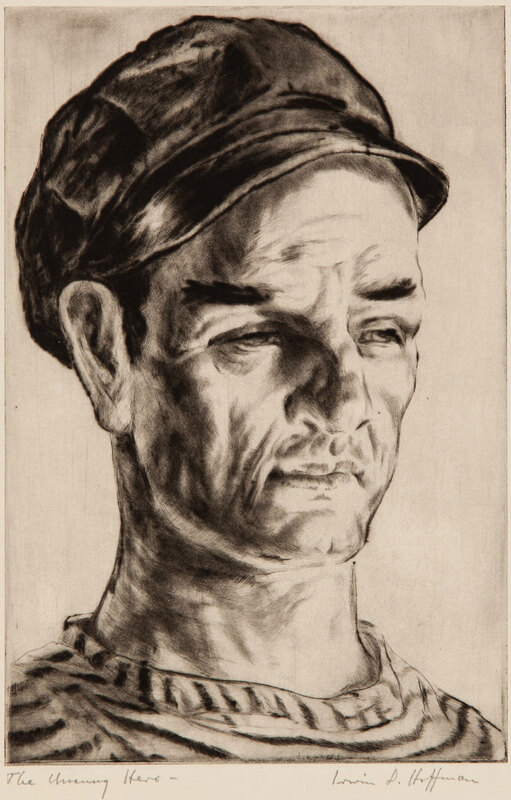War Time
The US government hired artists to create posters that urged people to support the First and Second World Wars – to buy war bonds, to conserve food, and so on. Some artists accompanied troops in the field while others remained home and designed propaganda posters.
The First and Second World Wars fundamentally reshaped the United States politically, socially, economically and culturally. Women’s participation in the First World War, for example, helped ensure the passage of the 19th Amendment, which was ratified a century ago in 1920. The ramifications of the Second World War were even greater due to the United States’ more extensive participation. Not only did the nation emerge as a global superpower, but the experience of Black GIs helped spark the Civil Rights Movement of the 1950s and ‘60s.
Wartime also created new opportunities for American artists. Their role was much like that of those who worked for the federal government in the New Deal: portray the lived experience of Americans and inspire a clear national sense of duty. The difference was that during wartime, artists also created posters that inspired Americans to give to the war effort. In this selection, there are posters calling on Americans to buy war bonds, which funded the First World War, and saving stamps. Others encouraged Americans to conserve food or to think twice about sharing information lest it fall into the enemy’s hands.
Several New Deal artists in this exhibit either began as war artists in the First World War or ended up becoming war artists in the Second. The first official government program to hire artists during wartime actually began during the First World War as part of the Committee on Public Information (CPI), which was created specifically to develop pro-war sentiment. Many of these artists ended up in the trenches, capturing day-to-day warfare. Others stayed at home and created propaganda posters, some of which became iconic—for example, the I Want You poster featuring Uncle Sam by James Montgomery Flagg (American, 1877 – 1960). This government art program continued during the Second World War, when over one hundred men served as “combat artists.”
This art helps us consider one important fact about war that we often neglect in our popular memory—it can be a very unpopular undertaking. President Woodrow Wilson (American, 1856 – 1924) developed the CPI during the First World War in part because the country was incredibly divided over America’s involvement. This was not only because a sizable number of immigrants hailed from the belligerent nation of Germany, but also because a huge anti-war movement lobbied hard to keep the United States out of the conflict entirely. Propaganda played an even more important part in Second World War, encouraging Americans to ration or give up daily goods like chocolate, rubber and gasoline—and people weren’t very happy to limit their driving! By creating art that encouraged Americans to think about the common good, war artists played an essential role in mobilization in both the First and Second World Wars.
––CCG
Unknown artist
Remember Your First Thrill of American Liberty, 1917
color lithograph; 30 x 20”
private collection, promised gift to Roberson Museum and Science Center
Interpretive text has not been prepared for this object.
Howard Chandler Christy (American, 1873 – 1952)
Fight or Buy Bonds, 1917
color lithograph; 40 x 30”
private collection, promised gift to Roberson Museum and Science Center
Interpretive text has not been prepared for this object.
Eugenie De Land (American, 1872 – 1961)
Before Sunset Buy a US Government Bond, 1917
color lithograph; 30 x 20 ¼”
private collection, promised gift to Roberson Museum and Science Center
Eugenie De Land, who made a career teaching art in the Washington, DC area, was one of only a handful of female artists who designed posters for the US government during the First World War. In her original watercolor study for this poster, Sunrise or Sunset Own a Liberty Bond (1917), De Land had already arrived at the idea of presenting the Statue of Liberty as a metaphor for America, with the country’s flag waving atmospherically in the background. The phrase “Before Sunset” perhaps had two meanings—first, reminding Americans to purchase a war bond on their way home; and second, suggesting they buy a bond before the “sun set” on American liberty.
This poster advertised the second Liberty bond program which launched in October 1917—there were a total of four between 1917 and 1918. By the end of the First World War, about half of all American families had purchased war bonds, which helped finance the war effort.
––CCG
William Balfour Ker (American, born Canada, 1877 – 1918)
Buy United States Government War Savings Stamps, 1917
color lithograph; 30 x 40”
private collection, promised gift to Roberson Museum and Science Center
A variegated cast of naturalized Americans—their countries of origin signaled by their distinct costumes and headgear, from an Ottoman fez to a Tyrolean hat—lines up at a window tended by a smiling Uncle Sam beneath a sign that reads “WSS For Sale Here.” War Savings Stamps—available in 10¢ and 25¢ versions, or just over $2 and $5 in today’s value—was a patriotic program that helped to fund America’s participation in the First World War.
William Balfour Ker was himself a naturalized American, having been born in Canada; his family moved to the United States when he was a child and he became a citizen in the 1890s. A committed socialist, his art often expressed his sympathies for America’s poor and downtrodden.
––CCG
Sidney H. Riesenberg (American, 1885 – 1971)
Over the Top for You, 1918
color lithograph; 30 x 19 ¾”
private collection, promised gift to Roberson Museum and Science Center
Interpretive text has not been prepared for this object.
Clayton Knight (American, 1891 – 1969)
Flying Fortresses at Work, 1943
lithograph; 11 ½ x 16”
Binghamton University Art Museum, 2016.4.315
gift of Gil and Deborah Williams
Born in Rochester, New York, Clayton Knight studied art in Chicago before settling in New York City. In 1917, he volunteered to be an aviator and flew missions with the Royal Air Force. This wartime experience inspired Knight’s later art, which was largely focused on aviation.
Knight made this lithograph when he was an official artist for the US Air Force during the Second World War. Perhaps his experience as a pilot influenced the composition, which takes us into the sky among the planes. In it, four Boeing B-17 Flying Fortress bombers float high above the clouds, dropping bombs. Flak, likely shot from German anti-aircraft guns, explodes around the planes. B-17s dropped more than 640,000 tons of bombs on Germany during the war.
––CCG
Harry Gottlieb (American, born Romania, 1895 – 1992)
Damn the Torpedo!, 1942
color screenprint; 16 ½ x 22”
Binghamton University Art Museum, 2016.4.245
gift of Gil and Deborah Williams
Interpretive text has not been prepared for this object.
Irwin D. Hoffman (American, 1901 – 1989)
The Unsung Hero, 1942
drypoint; 13 x 10”
Binghamton University Art Museum, 2016.4.159
gift of Gil and Deborah Williams
Irwin D. Hoffman was the son of Russian immigrants and grew up in Boston before settling in New York City in 1929.
In this portrait, Hoffman celebrates a member of the United States Merchant Marine—distinguishable by his striped shirt. The Merchant Marine was made up of civilians who transported cargo and passengers with their own ships, typically without Navy protection. During the Second World War, over 9,000 of these civilian men died, mostly in German U-boat attacks. The heaviest losses occurred in 1942, when Hoffman made this print. This is likely the reason Hoffman chose to title his piece The Unsung Hero, honoring these many men who died at sea.
––CCG

